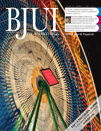BERKELEY, CA (UroToday.com) - This mini review provides a discussion around strategies to optimise repeat biopsy procedures and to better predict the biopsy outcome
As it is often uncertain whether a repeat biopsy should be performed in men with ≥1 previous negative prostate biopsies but persistent suspicion of prostate cancer.  The repeat biopsy may also be negative and a biopsy may be associated with anxiety, discomfort and occasionally (severe) complications. A search in PubMed was performed to find English language original and review articles related to repeat prostate biopsies. Strategies to optimise repeat biopsy procedures include applying the appropriate indications and adjusting the location and number of biopsy cores. The PROGENSA TM Prostate CAncer gene 3 (PCA3) Assay is a highly prostate cancer specific test. A higher PCA3 Score corresponds with an increased probability of a positive repeat biopsy and including the PCA3 Score in multivariate models signifi cantly increased their predictive accuracy for predicting repeat biopsy outcome. The PCA3 Score seems also to be predictive of future biopsy outcome. In clinical practice it is often uncertain whether a prostate biopsy should be repeated or not. Optimising repeat biopsy procedures and the use of diagnostic markers, such as PCA3, can increase the probability of a positive repeat biopsy and reduce the number of unnecessary and uncomfortable biopsies....View or save the full text Mini Review as a .pdf file
The repeat biopsy may also be negative and a biopsy may be associated with anxiety, discomfort and occasionally (severe) complications. A search in PubMed was performed to find English language original and review articles related to repeat prostate biopsies. Strategies to optimise repeat biopsy procedures include applying the appropriate indications and adjusting the location and number of biopsy cores. The PROGENSA TM Prostate CAncer gene 3 (PCA3) Assay is a highly prostate cancer specific test. A higher PCA3 Score corresponds with an increased probability of a positive repeat biopsy and including the PCA3 Score in multivariate models signifi cantly increased their predictive accuracy for predicting repeat biopsy outcome. The PCA3 Score seems also to be predictive of future biopsy outcome. In clinical practice it is often uncertain whether a prostate biopsy should be repeated or not. Optimising repeat biopsy procedures and the use of diagnostic markers, such as PCA3, can increase the probability of a positive repeat biopsy and reduce the number of unnecessary and uncomfortable biopsies....View or save the full text Mini Review as a .pdf file
| What’s known on the subject? and What does the study add? Due to the fear of missing clinically significant cancer, it is often uncertain whether a repeat biopsy should be performed in men with ≥1 prior negative prostate biopsies but persistent suspicion of prostate cancer. However, the repeat biopsy may again be negative and a biopsy may be associated with anxiety, discomfort and complications (resulting in hospitalisation in 4.1% of men). This review discusses strategies to optimise repeat biopsy procedures in order to better predict the biopsy outcome. Optimising repeat biopsy procedures include adjusting the location and number of cores and the use of MRI to detect suspicious areas. The use of diagnostic markers, e.g. (Prostate CAncer) gene 3, which is predictive of biopsy outcome, can aid in guiding repeat biopsy decisions and reduce the number of unnecessary and uncomfortable biopsies. |
Roger Kirby and John M. Fitzpatrick*
The Prostate Centre, London, UK , and *Mater Misericordiae Hospital and University College Dublin, Dublin, Ireland
More BJUI Mini Reviews and Archives


